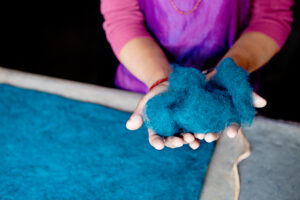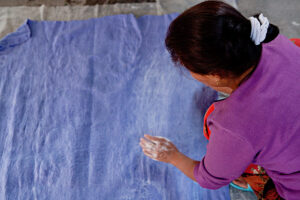
This is where the fun and the chemistry really kick into gear!
It’s hard to believe how many steps go into making a beautiful handmade good. In order to ensure quality, and to support consistency when working across language and with many artisans who may not be literate, we create tools to make it easier for all of us – wooden molds for the felting of our bags, or templates with holes drilled in to identify clear button placement on our silkscreen art panel bags. Then it is the wool cleaning and carding. One of my favourite things is the hand dyeing process – rooms full of steaming hot multi colored vessels, or open air at KTS, a big open bowl nested in a platform atop an open fire for their small batch dyeing. Then there is the spinning of the wool into yarn for our knitwear. And the wet felting is a huge part of what we do – wet wet everywhere and insanely physical work to layer after layer matte that wool with water and soap into the amazing and thick textile that results. After, the cutting, the sewing on mostly treddle sewing machines, hand stitching in the linings of bags, handles and details. There is the hand weaving and hand spinning of the cotton used in our hats, hairbands and strap liners for strength. Then there are the difficult to come by traditional leather workers who use unconventional approaches to naturally tan the leather used in our tote bag handle – using only indigenous village herbs and mustard oil. On to the detail work of blanket stitching, and sewing on buttons and each tiny one-by-one radiant bead, or the gorgeous hand silkscreening, layers of rich pigment gently pressed onto fabric.

Many artisans work at the fair trade facilities, or can work from home or in their village if more appropriate for their family life and childcare, or if the traditional skill is indigenous to their community. When complete, they will bring their products, sometimes from long distances, to the facility.
At the end of all this is our quality checking – a huge part of the work of a fair trade product. Because fair trade focuses on training and supporting new artisans – even from using scissors if an artisan has not been exposed to them before, to whizzing along on a traditional sewing machine – error, mentorship and re-do’s are a large part of our work. Our rejection rate can be high, and the painstakingly detailed work of us setting up systems to best support easy quality tools that speak to all, and to rectify unexpected mistakes can be….well….tough work, and a journey in risk and patience. But eventually we virtually always get there, and the result is magnificent and a triumph of true collaborative artistry!
